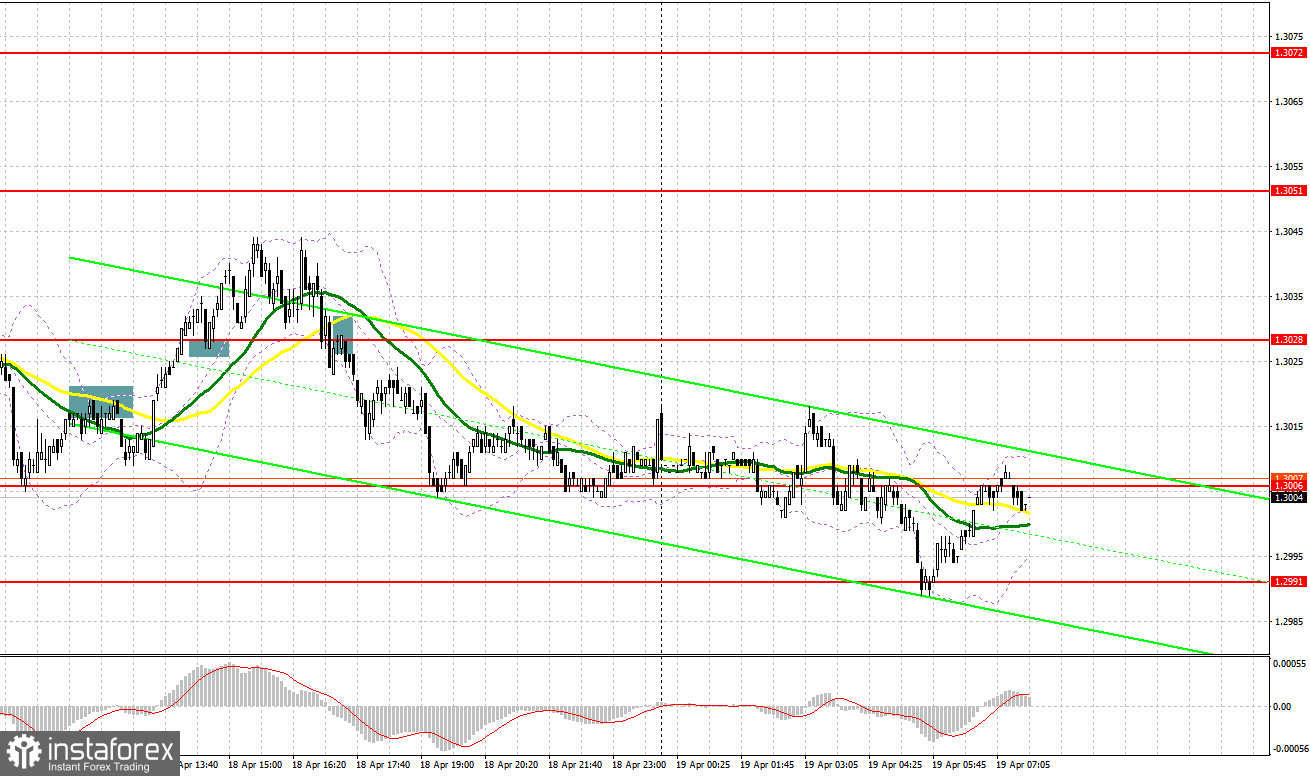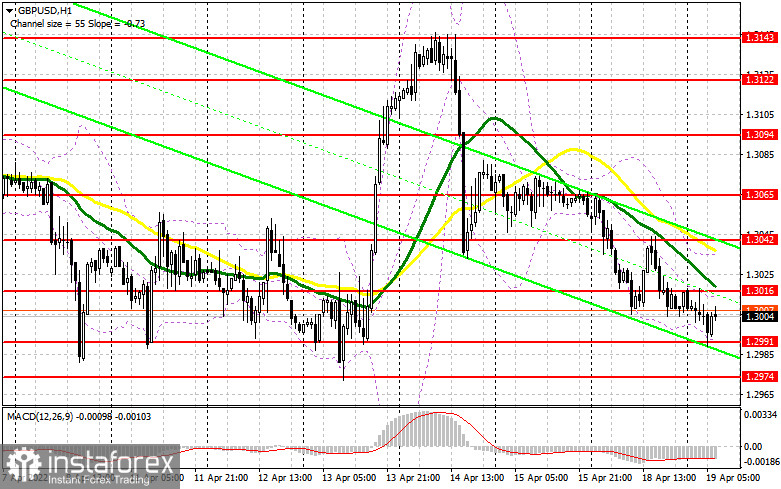To open long positions on GBP/USD, you need:
Much more interesting signals were generated yesterday afternoon than in the morning. I paid attention to the 1.3019 level in my morning forecast and advised you to make decisions on entering the market. Let's look at the 5-minute chart and figure out what happened. It did not take long for the breakthrough with the reverse test of 1.3019. As a result, a signal was formed to sell the pound in continuation of the bear market observed recently. Unfortunately, there was no major sale and after a while the bulls capitulated, allowing the pound to grow – losses were recorded on the deal. A breakthrough with a consolidation above 1.3028 and a reverse test from top to bottom of this range provided a signal for long positions. The upward movement was about 20 points from the entry point, but the signal did not lead to a larger upward correction. In the middle of the US session, the bears regained control over the 1.3028 level, and its bottom-up test led to a sell signal. As a result, the pair fell by another 20 points.
Before analyzing the technical picture of the pound, let's look at what happened in the futures market. The Commitment of Traders (COT) report for April 12 logged an increase in short positions and a reduction in long ones. All this once again confirmed the attitude of traders to the British economy, which is teetering on the brink of recession mixed with the highest inflation for a long period of time. The sharp rise in the consumer price index in March this year to another high of 7.0% once again proved the complexity of the situation in which the Bank of England (BoE) found itself, but the report on UK GDP, on the contrary, did not please traders much. The situation will only worsen, as future inflation risks are now quite difficult to assess due to the difficult geopolitical situation, but it is clear that the consumer price index will continue to grow in the coming months. At the same time, the soft position of the governor of BoE will push prices up. The pressure on the pound is also increasing due to the aggressive policy of the Federal Reserve, which is becoming more hawkish every day. In the US, there are no such problems with the economy as in the UK, so there the Fed can raise rates more actively, which it is going to do during the May meeting – another signal in the direction of selling the pound against the US dollar. The COT report for April 12 indicated that long non-commercial positions decreased from the level of 35,873 to the level of 35,514, while short non-commercial positions jumped from the level of 77,631 to the level of 88,568. This led to an increase in the negative value of the non-commercial net position from -41,758 to -53,054. The weekly closing price decreased from 1.3112 to 1.3022.

The bulls' attempt to stop the bear market only led to another major sale of the pound at more attractive prices. As of today, nothing indicates that bulls can somehow influence the situation, so I recommend sticking to short positions. The lack of fundamental statistics for the UK is likely to play on the bulls' side, since nothing good can be expected from macroeconomic data in the near future. In case the pair falls further, only a false breakout at 1.2991 will provide a buy signal that can return GBP/USD to the resistance area of 1.3016 formed by yesterday's results. However, we all understand the conditions in which the pound is currently located and that the bears will become more active with each significant increase. The reason for the build-up of short positions is the governor of the Bank of England, Andrew Bailey, with his soft policy, and the chairman of the Federal Reserve, Jerome Powell, with his hawkish approach to interest rates. Only a breakthrough and a test of 1.3016 from top to bottom will create another entry point into long positions, which will strengthen the demand for the pound and lead to growth in the area of the high at 1.3042, where the moving averages are playing on the bears' side. The 1.3065 area is another target, where I recommend taking profits. However, we can only reach this level with very positive news about the reduction of the conflict between Russia and Ukraine. In case the pound falls during the European session and the lack of activity at 1.2991, and everything is going to this, it is best to postpone long positions to this month's low at 1.2974. Forming a false breakout at this level can temporarily stop the bearish trend and give an entry point in hopes of a short-term rebound of the pair up. You can buy GBP/USD immediately for a rebound from 1.2950, or even lower – around 1.2911, counting on a correction of 30-35 points within a day.
To open short positions on GBP/USD, you need:
Bears are still feeling quite calm today, and most likely this calmness will remain. The deterioration of the geopolitical situation plays into the bears' hands, but if it improves, the bears will quickly leave the market, which will lead to a rapid growth of the pound – pay special attention to this. Trading is conducted below the moving averages, which indicates a likely decline in the pound in the short term. The primary task is to protect the 1.3016 range. Forming a false breakout at this level will provide an entry point into short positions with the goal of continuing the bear market and then updating the monthly low around 1.2974. You will have to fight for this level, as there are a number of stop orders of speculative buyers. A breakdown and a reverse test from the bottom up of 1.2974 will dump GBP/USD to the lows: 1.2950 and 1.2911. The 1.2856 level is another target, where I recommend taking profits. If the pair grows during the European session and bears are weak at 1.3016, it is best to postpone short positions to 1.3042. I also advise you to open short positions there only in case of a false breakout. It is possible to sell GBP/USD immediately for a rebound from the high of 1.3065, counting on the pair's rebound down by 30-35 points within the day.

Indicator signals:
Trading is conducted below the 30 and 50 moving averages, which indicates a further decline for the pair.
Moving averages
Note: The period and prices of moving averages are considered by the author on the H1 hourly chart and differs from the general definition of the classic daily moving averages on the daily D1 chart.
Bollinger Bands
A breakthrough of the lower limit of the indicator in the area of 1.2990 will increase the pressure on the pair. Surpassing the upper limit in the area of 1.3035 will lead to a new wave of growth of the pound.
Description of indicators
- Moving average (moving average, determines the current trend by smoothing out volatility and noise). Period 50. It is marked in yellow on the chart.
- Moving average (moving average, determines the current trend by smoothing out volatility and noise). Period 30. It is marked in green on the chart.
- MACD indicator (Moving Average Convergence/Divergence — convergence/divergence of moving averages) Quick EMA period 12. Slow EMA period to 26. SMA period 9
- Bollinger Bands (Bollinger Bands). Period 20
- Non-commercial speculative traders, such as individual traders, hedge funds, and large institutions that use the futures market for speculative purposes and meet certain requirements.
- Long non-commercial positions represent the total long open position of non-commercial traders.
- Short non-commercial positions represent the total short open position of non-commercial traders.
- Total non-commercial net position is the difference between short and long positions of non-commercial traders.





















